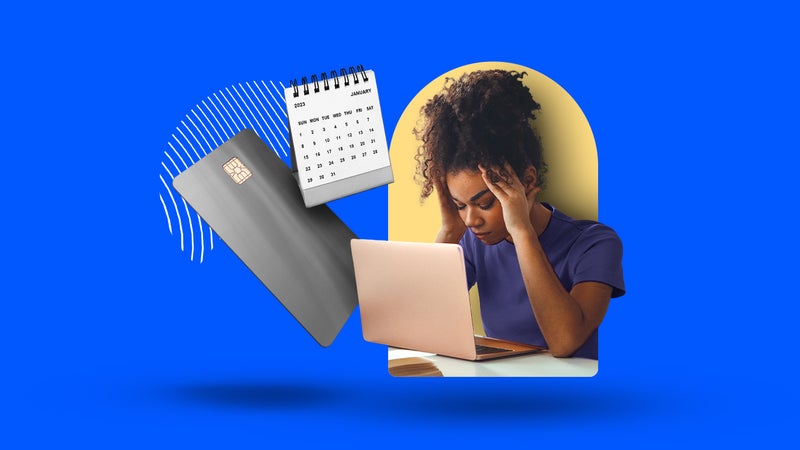4 ways to use credit cards to achieve your 2024 goals

The Bankrate promise
At Bankrate we strive to help you make smarter financial decisions. While we adhere to strict , this post may contain references to products from our partners. Here's an explanation for . The content on this page is accurate as of the posting date; however, some of the offers mentioned may have expired. Terms apply to the offers listed on this page. Any opinions, analyses, reviews or recommendations expressed in this article are those of the author’s alone, and have not been reviewed, approved or otherwise endorsed by any card issuer.
Key takeaways
- Credit cards are powerful financial tools that can help you reach your 2024 financial goals in a variety of ways.
- By using your credit card statements to break down your spending habits, you can create an accurate monthly budget and start using your credit card in a more targeted manner.
- Credit cards can also help you plan for any big expenses you have coming up this year, as well as pay down outstanding debts.
However you feel about formal New Year’s resolutions, the beginning of the year is a great time to evaluate your finances. If you haven’t already, take the time to set some financial goals for this year. Some goals might be specific, such as paying off a certain amount of debt, while others might be more general, like spending less on nonessentials or increasing your savings.
Credit cards can be a valuable tool in working toward many of those goals. New and existing accounts can help you develop and stick to a budget, pay down debt, and achieve wealth and financial well-being. Here are some ways credit cards can help you with your goals, starting now:
1. Use your credit card statements and tools to create a budget
Developing a budget can be challenging without historic data. Thankfully, your credit card statements can help you identify your spending trends so that you know where you need to make changes. Download about six months’ worth of your statements, then take notes while you do the following:
- Evaluate your transactions. You spent on what, where and how many times? Pay special attention to automatic charges, such as gym memberships, meal boxes and streaming services.
- Look for revolving debt. Look for months when you didn’t pay your statement balance in full. Ask yourself why and whether it was avoidable.
- Review the added fees and interest. Were you hit with fees or interest charges? Consider now how you would have better spent that money.
Almost all credit card issuers have mobile apps, and some of these tools provide spending breakdowns by purchase category. If yours does, check out the results. It can help you identify your most common (and costly) spending categories. With this information, you can create your budget. For example, in one column, you can list how much you’ve been spending each month on the following:
- Housing — Rent or mortgage (with insurance and taxes), home upkeep
- Transportation — Car payments, insurance, fuel, maintenance, parking, transit expenses
- Groceries — Supermarket food and household items
- Family care — Daycare, elder care, in-home caretaker, nanny
- Pet care — Pet food, pet products, dog walking service, pet boarding service
- Dining and drinking out — Fast food, restaurants, cafes, bars
- Utilities — Power, water, garbage, cellphone, internet
- Medical — Insurance premiums, copayments, prescriptions, supplements
- Other insurance — Life, disability, identity theft protection
- Education — Tuition, books, materials
- Personal — Gym, barber/salon, spa, clothes, home decor, gifts
- Entertainment — Streaming services, movies, games, sports, concerts
- Travel — Vacations, weekend trips, air and train fare, accommodations
- Saving — Fixed sum for savings and investments
- Debt — Credit card, student loan and personal loan payments
- Miscellaneous — Anything that doesn’t fit into the other categories
Subtract the total of this column from your monthly net income. If you’re spending more than you’re comfortable with, decide where you want to make changes in a second column. Do you want to reduce your dining expenses and add the difference to your savings? Or maybe you want to increase your vacation costs and cancel all streaming subscriptions.
This is your opportunity to direct cash where you want it to go. If your goal was to gain control of your money, this action will make you feel powerful.
If you’re using a budgeting app, you can also take this chance to examine your transactions and purchase categories and make sure that the app is categorizing your transactions properly. The app won’t be much help if it’s giving you inaccurate spending breakdowns.
2. Boost your bottom line with rewards earnings
If your goal is to earn more money, your credit card can come in handy. Cards with rewards programs will reward you when you make purchases with them, meaning that you’ll come out ahead when you pay your balance in full at the end of the month.
For example, let’s say that your budget revealed that you spend $2,000 each month. If you use a credit card with unlimited 2 percent cash rewards, such as the Wells Fargo Active Cash® Card, you will earn $40 in cash back each month.
You could also use a card that pays out higher percentages in certain categories. The Blue Cash Preferred® Card from American Express, for instance, offers a tiered cash back program. It can be great for a large family with many mouths to feed because it offers 6 percent cash back at U.S. supermarkets on up to $6,000 spent per year (then 1 percent back). Max out that category, and you’ll earn $360 per year — and that doesn’t even include the 1 percent cash back you’d earn if you spend more.
Look back at your credit card statements to ensure your rewards categories are working for you. If you’re not maxing out the highest earning categories, they may not make sense for your lifestyle. Check out the cards that do offer high rewards on the things you spend a lot on, and consider opening the one that fits your credit profile and charging habits.
In addition to cash back cards, also look at credit cards where you earn points or miles. If you have one of these accounts now, review your rewards. You may have racked up enough for everything from a round-trip flight or a bunch of gift cards. If your goal is to travel more in upcoming years, a travel credit card that’s co-branded with your favorite airline or hotel chain will help you get there.
3. Cut the cost of a big expense with a welcome bonus
While wishing for a pile of money to fall into your lap isn’t realistic, opening a new credit card and scoring a big welcome bonus can be a close alternative. You can use the bonus to slash the cost of a major expense.
What to buy something that costs $500? Consider a card like the Capital One Quicksilver Cash Rewards Credit Card, since you’ll earn a $200 cash bonus after spending that sum on purchases within the first three months of opening the account. If you put that sum toward your $500 purchase, you’ve effectively earned a 40 percent discount — and on top of that, you’ll still earn rewards on the purchase.
Or maybe you have a trip of a lifetime on the horizon. Look for a card that matches your traveling style. For example, if you prefer to stay at Hilton Hotels, check out the Hilton Honors American Express Card. There is no annual fee, and you’ll earn 70,000 Hilton Honors Bonus Points plus a Free Night Reward after you spend $2,000 in purchases on the Hilton Honors American Express Card in the first 6 months of Card Membership. Offer Ends 7/31/2024.
The key here is that the card should work for you well beyond the welcome bonus. So, when you go to apply for a new card with a big welcome bonus, make sure you’re thinking of both the present and the future.
4. Take advantage of 0 percent APR offers
If you’ve discovered that you’re carrying high-interest debt, a great goal for 2024 is to pay it off efficiently. One way is to move your debt to a 0 percent APR balance transfer card for a fee of usually three to five percent. Once done, you will have a fixed amount of time to repay your balance with no interest added to it at all. Some of these offers have a long introductory period, too — up to 21 months.
Another way to use these offers is to find one that gives you 0 percent APR on new purchases. Maybe you want to buy something expensive, such as a new laptop for your college-bound daughter, but you don’t want to spend $2,000 upfront. A card like the BankAmericard® credit card* will give you 18 billing cycles of 0 percent APR for purchases (with a variable APR of 16.24 percent to 26.24 percent after the introductory period ends).
In both of these scenarios, it will be essential that you stick to your budget. You constructed it carefully, so you should have enough money to make the payments and not carry over debt before the regular rate goes into effect. And remember that you still have to make at least minimum payments during the 0 percent APR period. Delinquent payments can nullify the 0 percent APR arrangement prematurely.
The bottom line
Think of your credit cards as powerful tools that you can use to your financial advantage. The moment you begin to feel out of control with your spending and charging, put the plastic down and reevaluate your budget. Identify the problem, then find out what you can do to fix it — and don’t be afraid to ask for help or advice as you do so. This is the year you really will reach your goals.
*Issuer-required statement
The information about the BankAmericard® credit card has been collected independently by Bankrate.com and was last updated on January 15, 2024. The card details have not been reviewed or approved by the issuer.
